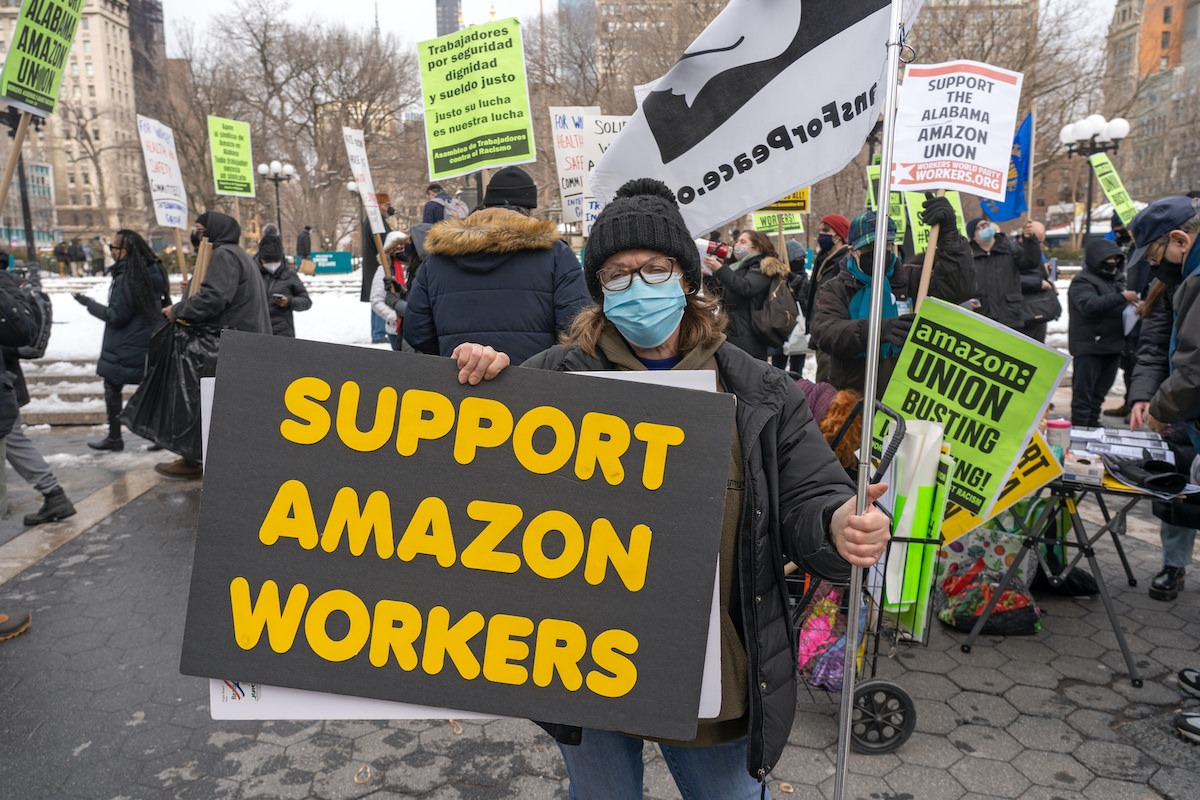In an iconic scene from the film Norma Rae, Sally Field—playing the eponymous title character—writes “UNION” on a piece of cardboard and holds it aloft in the plant that employed her. She has just been fired for copying a flyer to use as evidence of illegal actions to thwart unionization. Following a movie-appropriate period of tension, one by one each employee shuts down their workstation. The plant goes silent. Production stops. Eventually, it is unionized.
Recent events make it seem like reality is beginning to imitate Hollywood. Workers in over two dozen Starbucks stores voted to unionize earlier this year. So did employees at an Amazon warehouse in Staten Island. These victories give other workers hope that they too can organize and gain a stronger voice as well as some power in negotiating with their employer. As a result, unionization efforts are currently underway across the nation. The larger question is whether these efforts lead to a rise in the living standard of U.S. workers, which has stagnated over several decades, and improve their working conditions.
One reason for pessimism is the power large companies have to harass and fire union supporters and then request a union decertification vote. If these efforts fail, firms can refuse to negotiate in good faith. Another cause for pessimism is that government action to change business-labor dynamics is unlikely as long as Democrats lack the votes to counter Republican obstructionism in the Senate. A little background can help us understand these problems.
The 1933 National Industrial Recovery Act, part of Franklin Delano Roosevelt’s New Deal, gave U.S. workers the right to organize and bargain collectively for the first time. After the Supreme Court declared the act unconstitutional in May 1935 (claiming the term “fair competition” was vague and undefined in the law), the 1935 National Labor Relations Act revived some of its key provisions.
Following World War II, Americans held a positive view of unions—in no small measure because they didn’t strike during the war. But both union and nonunion workers were poorly compensated. The Great Depression, and then wage and price controls imposed during the war, kept wages low; and the end of wartime bonuses substantially reduced take-home pay. With low unemployment, unions saw an opportunity to change things.
The result was a large number of strikes, higher wages, and rising inflation. Public sentiment quickly turned against labor and Democrats. In 1947, Republicans gained control of Congress. On June 23, they passed the Taft-Hartley Act—named for Senator Robert Taft of Ohio and Congressman Fred Hartley of New Jersey, both Republicans—over President Truman’s veto. This June marks the act’s seventy-fifth anniversary.
Taft-Hartley was a conscious effort to reduce the bargaining power of labor. It allowed the U.S. attorney general to seek an injunction against strikes and enabled firms to seek union decertification. It prohibited wildcat strikes, solidarity strikes, secondary boycotts, and mass picketing. Even more important, Taft-Hartley made union membership and paying union dues voluntary. This created incentives for workers to opt out of providing the revenue the unions relied on to organize and represent their members.
Taft-Hartley also prohibited federal employees from striking. President Reagan used this provision in 1981 to fire air traffic control (PATCO) workers who struck over concerns that flying was unsafe because they were so overworked. In firing union workers, President Reagan sent a clear message that government would side with business over labor.
Businesses got it. They hired anti-unionization specialists and white-shoe management-side law firms to prevent unionization votes and, if that didn’t work, ensure the vote to unionize was defeated. Taft-Hartley aided these efforts. It enables employers to force workers to attend meetings where they are fed anti-union propaganda; at the same time, firms can prevent union organizers from communicating with workers at the workplace. Although employers in theory cannot fire workers for supporting a union or retaliate against union supporters by changing their working conditions, such practices have nonetheless proliferated. The meager penalty for violating these principles is reimbursing workers for any lost pay.
Following passage of Taft-Hartley, union membership fell steadily—from 35 percent after WWII to just 10 percent in 2021.
The nation lost more than just union members. Union workers, on average, earn 10 percent more than a worker performing similar tasks who is not a union member, and they are more likely to be covered by employer-funded health insurance. Unions ensure that labor receives a share of the gains in economic output generated by workers so that inequality does not spiral out of control. These benefits even spill over to nonunion workers as firms raise compensation rates for fear of losing employees to higher-paying unionized firms.
In addition, unions have been responsible for many workplace benefits that Americans take for granted—the 40-hour workweek, overtime pay, paid vacations, paid sick days, and paid maternity and paternity leave. They also give a collective voice to employees, preventing firms from abusing workers.
Unions also benefit employers. Union members are less likely to seek alternative employment, reducing the cost and frequency of having to hire and train new workers. And firms can negotiate pay and benefits with all workers at once rather than on an individual basis.
A failure to let workers discuss safety concerns during the Covid-19 pandemic seems to have turned the tide, especially with many firms desperately seeking employees due to retiring baby boomers and reduced labor force participation by prime-age adults. After decades of stagnant wages and worsening working conditions, workers feel they can support unionization efforts and strike if necessary. Even if their efforts fail, plentiful jobs are available at around the same wage.
In addition to the many successful unionization votes, unions are seen more favorably than at any point since the 1960s. Over two-thirds of Americans approve of unions, and more than half of nonunion workers say they would join a union if given the option.
A turning tide alone, however, won’t equalize the bargaining power between business and labor. Firms begin with many advantages. Having more wealth, they can outlast workers during a strike. Also, firms can close a unionized plant or store at will, causing severe hardship for those who lose their jobs. In contrast, workers can’t permanently shut down thousands of Starbucks stores, threatening the company with bankruptcy. Last but not least, Taft-Hartley and Republican hostility toward unions have put the laws of the land on the side of business in labor disputes.
What might level the playing field?
Passing the Protect the Right to Organize (PRO) Act would help. PRO seeks to repeal the more egregious provisions in Taft-Hartley. It prohibits intimidating workers or questioning them about their views regarding unions. It imposes penalties on firms for retaliating against workers seeking to form a union. It prevents workers from being forced to attend anti-union meetings. It prohibits employers from permanently replacing striking workers and permits labor to engage in secondary strikes. And it overrides state “right to work” laws, which are fundamentally about weakening unions and creating lower wage environments for employers. Right to work laws prohibit unions from negotiating a contract that requires all employees to contribute to the collective bargaining effort, even though it benefits everyone. PRO passed the House with only five Republican votes. Contrary to Republican claims of being pro-union, a Republican filibuster prevents the bill from even coming to the Senate floor for a vote.
Reining in corporate power is also a priority. This includes prohibiting mergers and acquisitions, as well as breaking up monopolies and quasi-monopolies. Equally important is curbing practices that limit employee rights—such as prohibiting firms from reclassifying employees as contract workers (a simple solution to unionization efforts) and prohibiting noncompete clauses in worker contracts. Such clauses keep someone from going to work for a competitor—for example, leaving a job at Subway to take a job at another sandwich shop—for months or even years. Workers thus become indentured servants, unable to find a similar job at higher pay or do anything that puts their current job at risk.
Given repeated Republican failures to support workers, action now must come from the president through an executive order. A White House Task Force on Worker Organizing and Empowerment issued a report in February with nearly 70 recommendations for strengthening union organizing and worker rights. Its most important recommendation is that strong labor standards should be a condition for receiving government monies. If this becomes policy, firms seeking government contracts stemming, for example, from the $1 trillion infrastructure bill passed last November will have to maintain good labor relations. While this would be a big step forward, the next Republican president can reverse any changes made by President Biden—unless long-overdue legislation gets passed. This will require that Democrats hold the House in the November midterm elections, pick up at least one Senate seat (Pennsylvania and Wisconsin are both good candidates for this), and then vote to end filibusters in the Senate. We shouldn’t have to wait another 75 years before overthrowing Taft-Hartley.
Steven Pressman is professor emeritus of economics and finance at Monmouth University and author of Fifty Major Economists, 3rd edition (Routledge, 2013).




